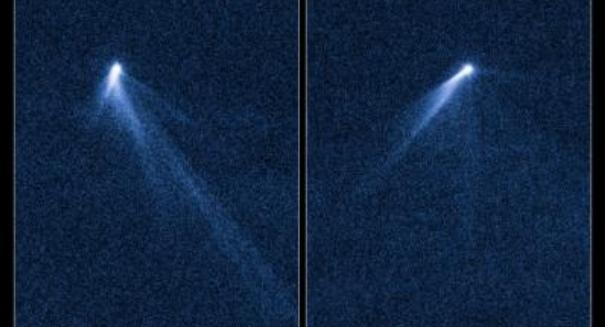
They do not believe that the six tails are the result of a violent accident with another asteroid because they have not detected a large quantity of dust ejected into space all at once.
NASA’s Goddard Space Flight Center reports that astronomers have discovered a strange six-tailed asteroid, called P/2013 P5. Data from the space agency’s Hubble space telescope suggest that the unusual asteroid resembles a spinning lawn sprinkler. Normally, asteroids appear to be tiny points of light. P/2013 P5’s “freakish” appearance has perplexed astronomers.
“We were literally dumbfounded when we saw it,” remarked lead investigator David Jewitt of UCLA. “Even more amazing, its tail structures change dramatically in just 13 days as it belches out dust. That also caught us by surprise. It’s hard to believe we’re looking at an asteroid.”
According to astronomers, P/2013 P5 has been tossing out dust again and again for at least five months. They believe that it is probably P/2013 P5’s rotation rate increased to the point where its surface started flying apart. They do not believe that the six tails are the result of a violent accident with another asteroid because they have not detected a large quantity of dust ejected into space all at once.
Astronomers discovered the asteroid utilizing the Pan-STARRS survey telescope. They announced their finding of P/2013 P5 on August 27, noting that the asteroid was a strange fuzzy-looking space object. Hubble revealed several tails on September 10, but by September 23 the telescope showed that its appearance had completely changed. It appeared as if the whole structure had swung around.
Jessica Agarwal of the Max Planck Institute for Solar System Research demonstrated through her computer modeling work that the tail could have been formed by several impulsive dust-ejection events. She found that dust-ejection events occurred April 15, July 18, July 24, Aug. 8, Aug. 26 and Sept. 4. She noted that radiation pressure from the sun spread out the dust into streamers.
Jewitt posited that the spin rate could have increased enough that P/2013 P5’s weak gravity no longer could hold it together. If that occurred, dust could slide toward the asteroid’s equator, shatter and fall off, and journey into space to form a tail. If the dust leaves the asteroid in the equatorial place, this would be great evidence for a rotational breakup.
The study’s results are published in the Astrophysical Journal Letters.
Leave a Reply